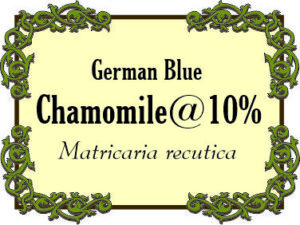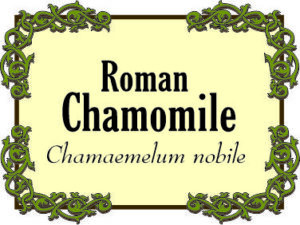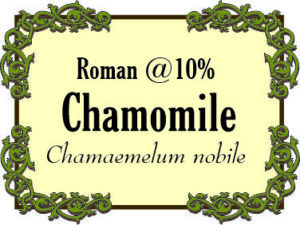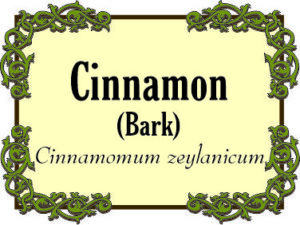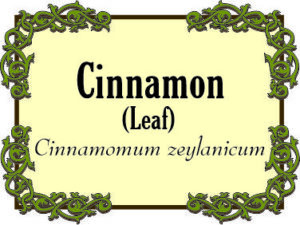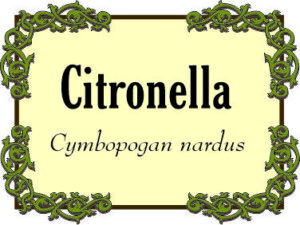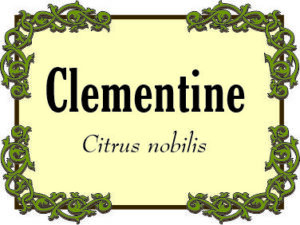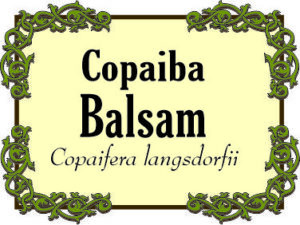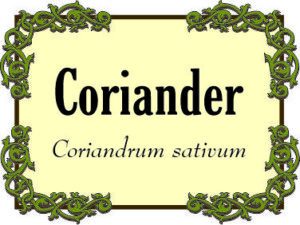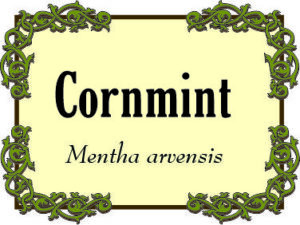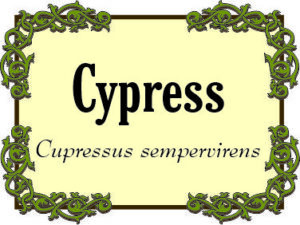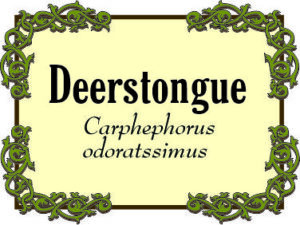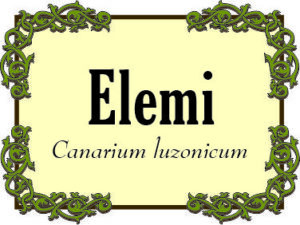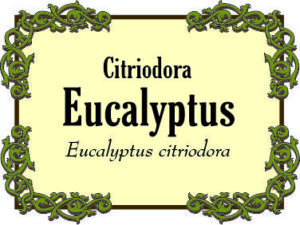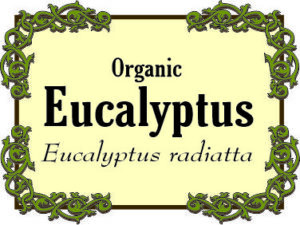

Cedarwood, Virginian
Also known as Red cedar, it is from the family Cupressace. Although this tree is from this family and not from the family Pinace, it is still called Virginia Cedar. Its scent is sweet and woody, sometimes reminiscent of sandalwood. Calms nervous tension and states of anxiety. Expectorant, dries phlegm. Deters moths and other insects, usually in drawers and closets. Care should be taken that garments do not directly touch wood treated with Cedarwood essential oil. Blends well with bergamot, cinnamon, frankincense, rose, sandalwood and rosemary.
Chamomile, German
This essential oil was distilled often in Germany from Hungarian raw materials which may explain the term "German" Chamomile. The unique soil and climate of Bulgaria is known for imparting many of the finest nuances in the Industry (i.e. Lavender, Rose). The reason for the deep beautiful blue hue is the natural constituent, a hydrocarbon; chamazulene. The chamazulene content gives German chamomile its most important actions such as soothing, calming and anti-inflammatory. It is widely believed this constituent does not affect the aroma. The odor is intensely sweet, coumarin-like, herbal and slightly fruity. The dry out notes are warm and pleasant like sweet tobacco.
Chamomile, German @10%
Due to the expense and intensity of Roman Chamomile, we offer it in a 10% dilution in jojoba oil. This essential oil was distilled often in Germany from Hungarian raw materials which may explain the term "German" Chamomile. The unique soil and climate of Bulgaria is known for imparting many of the finest nuances in the Industry (i.e. Lavender, Rose). The reason for the deep beautiful blue hue is the natural constituent, a hydrocarbon; chamazulene. The chamazulene content gives German chamomile its most important actions such as soothing, calming and anti-inflammatory. It is widely believed this constituent does not affect the aroma. The odor is intensely sweet, coumarin-like, herbal and slightly fruity. The dry out notes are warm and pleasant like sweet tobacco.
Chamomile, Hungarian
Relaxing, soothing, calming the nerves without being a sedative (great for kids!), very gentle oil. This oil smells just like Chamomile tea. Recommended for the diffuser and blends to impart a sense of calming. Does not have the anti-inflammatory properties of German or Roman Chamomile. Great skincare properties, soothing irritation and balancing the skin's functions. Blends well with: Geranium, Lavender, Rose, Neroli, Marjoram, Cedarwood, Frankincense, Rosewood, Clary Sage, Ylang Ylang and others. Chamomile adds a soft, warm note to a blend.
Chamomile, Roman
It is very warm, sweet, comforting, slightly bitter and somewhat green. Roman Chamomile is more fruity and somewhat apple-like in aroma. This oil is very fragrant and shares a lot of the properties of the other Chamomile species. Relaxing, soothing, calming the nerves without being a sedative (great for kids!), very gentle oil for many skin conditions, digestive problems and stress. Great skincare properties, soothing irritation and balancing the skin's functions. Its mildness, as well as its proven effectiveness makes it a universal remedy, even in baby care. Blends well with Geranium, Lavender, Rose, Neroli, Marjoram, Cedarwood, Frankincense, Rosewood, Clary Sage, Ylang Ylang and others. Chamomile adds a soft, warm note to a blend. This herb has been used for medicinal purposes and skin therapy for a long time, in particular in Europe. German/Blue Chamomile and Roman Chamomile have very similar properties, however the German/Blue oil is better for anti-inflammatory applications, because it has a higher content of Azulene.
Chamomile, Roman @10%
Due to the expense and intensity of Roman Chamomile, we offer it in a 10% dilution in jojoba oil. This essential oil was distilled often in Germany from Hungarian raw materials which may explain the term "German" Chamomile. The unique soil and climate of Bulgaria is known for imparting many of the finest nuances in the Industry (i.e. Lavender, Rose). The reason for the deep beautiful blue hue is the natural constituent, a hydrocarbon; chamazulene. The chamazulene content gives German chamomile its most important actions such as soothing, calming and anti-inflammatory.It is widely believed this constituent does not affect the aroma. The odor is intensely sweet, coumarin-like, herbal and slightly fruity. The dry out notes are warm and pleasant like sweet tobacco.
Cinnamon Bark
The dry, spicy notes of this unique Cinnamon Bark oil are finer and more complex than other Cinnamons. Great for pain relief in a 3% dilution. It has a strong aroma that is exceptionally tenacious along with the highest quantity of volatile components for aromatherapy use. Do not use if pregnant.
Cinnamon Leaf
Lighter than the Cinnamon Bark oil. This oil mixes well with almost all of the citruses and is the most commonly used in soapmaking. Do not use if pregnant
Citronella
Light, fresh lemon scent with geranium-like notes. Very soft and round. Citronella's properties are similar to Lemongrass, its scent however, is less appealing to many people. Commonly used in deodorizing and insect repelling products, and as a raw material for the perfume industry. Citronella works well in blends designed to keep insects at bay, for example, in combination with Cedarwood, Lavender, Patchouli or Eucalyptus. You can also add a few drops to mopping water when mopping your home. Citronella blends well with a lot of different oils, "lifting" a blend to make it appear more energetic and lively. Lavender, Neroli, Ylang Ylang, Rose, Sandalwood, Frankincense, Geranium, Fennel, Tea Tree, resinous Essential Oils and many others Avoid in pregnancy. Do not use directly on the skin.
Clementine
Clementine is a cross between a sweet orange and mandarin. Crisp and fresh aroma. This is a cold pressed oil from the peel and contains between 85-92% limonene. Great for uplifting and energizing in a blend. Has also been used with other oils such as Chamomile, Rose and Lavender for insomnia. Clementine Essential Oil is phototoxic and exposure to strong sunlight should be avoided for up to an hour after application. Avoid use during pregnancy.
Copaiba Balsam
Mainly found in South America, Copaiba Balsam is great for pain relief. Has an earthy and warm aroma.
Coriander
Coriander has an aroma that is green, sharp and slightly pungent. Coriander is considered anti-inflammatory and sedative. It's indicated for stress, anxiety and insomnia. May help memory, stimulates the mind. Used as a massage oil to ease arthritis pain and migraine headaches. Can also be applied to clear blackheads and for oily skin. Blends well with bergamot, lemon, grapefruit, cedar and sage.
Cornmint
Cornmint contains a very high content of menthol and can be used in the same way as peppermint. Anesthetic, antimicrobial, antiseptic, antispasmodic and carminative. Blends well with Rosewood, all citruses, Eucalyptus, Geranium and Rosemary. Essential Oils are highly volatile, meaning they readily evaporate, transforming from liquid to vapour. Keep your oils out of sunlight, but do not refrigerate.When deciding on a lid, there are a few things to keep in mind. Droppers are great when working on recipes, because you can count the drops, but if you store the dropper in the vial, the oil will eventually deteriorate the rubber, ruining your precious oil. So, store separately, especially if you do not use the oil promptly. Wands are good for skin application. The reducers are good for thinner viscosity oils but not for heavy oils like frankincense. Tap the bottom of the bottle to deliver the oil.
Cypress
Cypress oil has a sweet, balsamic aroma that is slightly similar to Pine, Juniper Berry, and Cardamom without traces of cineole. Cypress is thought to bring calming in times of sadness, and has a long standing spiritual history. Cypress oil blends really well with Labdanum oil and blends.
Deerstongue
Obtained from vanilla leaves. Warm with a slight hint of vanilla-like aroma. Used as a fixative in aromatic blends.
Elemi
Elemi is said to stimulate the immune system, is used as an expectorant and to open up air passages. Aids sleep. Is also used for muscle and nerve pain and for certain skin conditions such as acne, scars and fungus. Its aroma is light, fresh with a faint lemony odor and sweet/spicy undertones. Obtained thru steam distillation of the resin.
Eucalyptus, Citriodora
Also known as Lemon Eucalyptus, naturally, it has a fresh and lemony scent. Useful as an anti-inflammatory and an anti-bacterial.
Eucalyptus, Globulus
Most aromatically recognizable as Eucalyptus. Commonly known as blue gum. Its scent is camphorous with a woody sweet undertone. Some of this oil's properties are expectorant, decongestant, insecticide, analgesic, antirheumatic and antiseptic. Inhibits proliferation of the cold virus. Deters mosquitoes and other insects. Cools emotions, aids concentration. It is one of the most valuable oils for treating the respiratory system. According to research, the spraying of a 2% emulsion containing eucalyptus oil kills off 70% of local & airborne staphylococci. Blends well with basil, cedarwood, lemon, vetiver, peppermint and clary sage.
Eucalyptus, Peppermint
This oil has a clean and medicinal smell and has a higher menthol content than the E. Globulus.
Eucalyptus, Radiatta
Camphorus and slightly sweet. A much smoother aroma than the more common E. globulus. Supposedely, less irritating than other Eucalyptus species.
Fennel, Sweet
Almost smells like licorice. Blends well with: Bergamot, black pepper, cardamom, cypress, dill, fir, geranium, ginger, grapefruit, juniper, lavender, lemon, mandarin, marjoram, niaouli, orange, pine, ravensara, rose, rosemary, sandalwood, tangerine, ylang ylang.
Fir Needle
Useful as an inhalation for anxiety and stress. Its warming effect is beneficial in massage blends for the relief of muscular aches and pains due to rheumatic or arthritic conditions. Blends well with basil, cajeput, cedarwood and frankincense.
Fir, Douglas
Douglas Fir oil has a pine-like, fresh, sweet, balsamic aroma that it believed to be a great antiseptic and often used to support respiratory health. The aroma is great for forest, outdoor, or holiday blends in soaps, deodorants, and aromatherapy.



